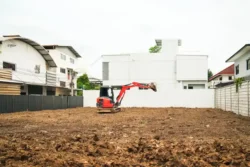What to look for when inspecting commercial property
Published
April 25, 2023
Published
April 25, 2023

The early introduction to a commercial property investment is usually from high resolution images, catchy headlines, and a seductive smile from the real estate agent’s photo on a sales brochure. However, not until jumping in the car (or getting on the plane) and heading on-site will an opportunity leave or lose its impression on you.
Here’s what to look for when you first visit your targeted commercial property:
- Access
- Nearby businesses
- Public transport
- Vacancies
- Tenant inside information
- Visual and practical appeal
- Signage and exposure
- Age of the building
- Plant and equipment (and its condition)
Get these things right and you’ll know whether it’s an opportunity to look further into.
Let’s dive in further to these commercial property inspection ‘must-knows’:
1. Access
During the drive to check out an asset, there are a number of things you can notice if paying attention:
- Take into account the distance the property lies to major roads (or perhaps it’s sitting on one).
- For retail premises, check out the shop’s location on the street. Is there ease of entry/exit for customers? Is the property nearby traffic lights? Customer comfort and convenience is essential, so even the road condition is important.
- For industrial assets, have a look at the width of the roads and the traffic flow. Is the route in and out of the property suitable for heavy vehicles to make deliveries?
2. Nearby Businesses
If you have a Snooze as your anchor tenant, it could be a huge win having a Bedshed next door. Why? People want convenience.
More activity in your retail property’s area – where large numbers of qualified shoppers are attracted – should mean more foot traffic through your tenant’s doors. A competitor as your neighbour has a pulling power effect for customers. The more competitors, the better.
3. Public Transport
Now if your tenant’s customers aren’t driving, how are they getting to the site?
Check for bus stops and even the bus route. A nearby train station is a huge plus, especially if it’s a short walk to your property.
4. Vacancies
Look for empty properties nearby as a suburb filled with vacancies is typically a negative. Good positioned properties don’t usually stand vacant.
And while agents may not intentionally deceive potential buyers, tenancy schedules may have discrepancies or outdated information. So, it’s good practice to check firsthand for any vacancies that may not have been noted in the tenancy schedule.
5. Tenants (talk to them)

Tenants will want to tell you everything that’s wrong with their premises.
This is their chance to nit-pick – and yours to understand future replacement costs. Ask them about the air conditioning, leaks, problems with parking, ease to get in and out of the property. Even more importantly, ask them how business is going. The tenants do tell all.
Find the vendor and ask why they are selling. You may find the hidden flaws of the premises by an honest answer. Speaking of honesty, if the vendor is a tenant, beware of inflated rents.
And finally, make sure at least one tenant visit is during peak hour. Then you can see how the car park handles large traffic flow.
6. Visual and Practical Appeal
We’ve lost count of the times we’ve had to replace a property’s gardener. So, check the condition of the gardens and landscape while on-site.
Again, while in the car, notice whether there is undercover or shaded parking when you pull up. For vehicles parked in the middle of summer, customers would prefer a cool vehicle to drive home in.
Toilets should be easy to find, easy to access and well maintained. As always, keep customer convenience in mind.
7. Signage and Exposure
If a property sees 40,000 passing cars a day, it doesn’t necessarily mean good exposure. Signage must be done right. This might mean having a large, illuminated pylon so your tenants are exposed day and night.
Or perhaps there’s no signage at all, which may represent a huge problem… or opportunity.
8. Age of the Building
Under the Income Tax Assessment Act (ITAA), a deduction for the cost of a commercial building earning income can be spread over 40 years. That works out to be 2.2 per cent per annum.
Note: This deduction is on the original building cost and the cost of any improvements since the original build. You can learn more about what capital gains tax means for commercial property here.
This ‘capital allowance’ is a deduction each and every year for 40 years after the building commences to be rented (or is available to be rented). The younger the building, the better for remaining annual deductions. What makes this perk so attractive is there’s no cost! There is no cash outflow to get what can be a very large recurring deduction. This most often results in ‘tax free’ additional cash flow to the investor, because such capital allowances reduce the capital gains tax cost base, which only has effect when you sell.
So, check the age of the building to understand how attractive your tax deductions look.
9. Plant and Equipment (and its condition)
Just like the age of the building, plant & equipment can be depreciated over their useful life. And that annual depreciation amount can be claimed as a deduction. So, look inside the building and see what can be depreciated.
You can even accelerate that deduction if you elect to apply ‘diminishing value’ and if the remaining amount falls below $1,000 then you can choose to assign that amount to a ‘low value pool’ with an even faster rate of depreciation. That way, for example, the younger the air conditioning, light fittings, security systems, the better the greater annual depreciation claims.
And, once again, there’s no cost to this powerful perk. Just like capital allowances, this most often results in tax-free additional cash flow to the investor. How’s that for adding value.
Arming yourself with these considerations will help you decide whether or not to place an offer on the property. And the week after it’s under contract, the crucial due diligence process begins… More on this in a later post.
Not every property is the same, meaning your questions and attention will change depending on the opportunity. Experience will help you with this.
For more information on investing alongside an experienced commercial property syndicator, get in touch with Properties & Pathways.






